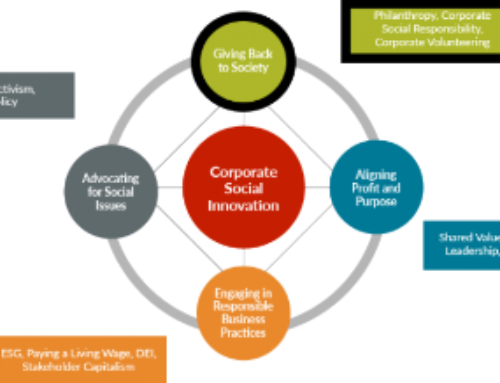Is it possible that the HR department can have more impact on sustainability than the Sustainability department? Every employee at BASF’s Livonia Plant in Livonia, Michigan is a player in the company’s sustainability efforts. During evaluations, plant workers—from middle managers down to factory floor workers—must set sustainability goals for their job and be able to articulate what sustainability means to them.
Why are chemists and administrators being asked to define sustainability goals for their work? A better question would be: Why isn’t that standard practice in every company.
Over the past two years, I embedded myself in nine companies—all of them sustainability leaders, but none of them common sustainability media darlings—to find out what worked, what didn’t, and what needs to happen next to take sustainability to the tipping point.
I found that commitments to sustainability were strong, but many companies struggled to take their programs to the next level. I also found ample evidence that the future of sustainability rests not with the sustainability/CSR department, but in the most unlikely of places: Human Resources.
We’ve made a lot of progress in the last 10 years, but sustainability is in danger of stalling out. The next stage in the evolution of sustainability is to reach every employee—not just in the C-suite, but at each level of operations. That’s because sustainability lives and dies in the day-to-day decisions made, not just by CEOs, but by everyday employees—middle managers, customer service reps, factory workers, and others.
Sustainability “happens” when a middle manager makes decisions and takes actions in ways that reflect not just the ways of financial profit and loss but of sustainability gain and harm. It happens when a unit leader encourages a team to vet social impact and ethics questions in a team meeting at the same time that they’re vetting options for growing the bottom line. It happens at those everyday levels.
Even the best laid sustainability efforts will fail if employees at all levels aren’t playing a part. If only half the people in your company are involved in sustainability, your goals will only ever be half-fulfilled.
Let’s Shift the Center of Gravity
In the vast majority of companies today, sustainability and CSR programs are managed out of a dedicated function. Those departments have brought us a very long way. But they too often operate in a silo, and they simply can’t reach everyone, everywhere, on their own.
This was borne out in a BSR survey last year, which found that sustainability offices connected to supply chains, the C-suite, and PR departments, but very little to other parts of the company. The center of gravity, so to speak, is set in departments and functions that few employees ever interact with or affect.
We need a shift in the center of gravity; from a siloed department that has little involvement with employees at large to the single department that touches every employee: HR.
Sustainability is intrinsically tied to the types of people you recruit, how you onboard them, how you steer “culture” internally, how you keep accountability, and what professional development programs, incentives and raises you provide. All those things put HR in the perfect position to steward a shift toward total employee involvement in sustainability.
Through my research, I found that one of the biggest stumbling blocks for sustainability efforts is with middle managers. They are the most likely to be trapped between different types of signals and incentives. They’re also the ones who make the daily business decisions that determine what gets done versus what simply gets talked about—and therefore are in a position to make or break sustainability.
But who can blame them for being stuck? In the face of competing signals, employees are likely to revert to old, internalized signals about business—making every decision exclusively or primarily according to finances. That’s basic psychology. The key is to introduce new factors more aggressively and reinforce them universally—from every meeting to every performance review.
To address the problem and reach those middle managers, HR will need to play a central role. We’re redefining how people see their jobs and we’re rejiggering the system of goals and rewards in a way that sustainability departments simply cannot do alone.
Two Critical Roles for HR Managers
Let’s get back to BASF. Far from an anomaly, their Livonia Plant is actually the result of a company-wide policy, making every employee part of the company’s sustainability strategy. BASF found that without engagement with the middle and lower rungs of the corporate ladder, sustainability efforts were lagging and critical problems—especially those observed on the front lines—weren’t being addressed.
So they did two essential things: They required every employee to establish sustainability goals for themselves and be able to articulate them; and they integrated those goals into annual evaluations.
Sustainability strategies can be awfully big and confusing things. For everyday employees they can be nearly impossible to decipher. Requiring that each employee sets their own goals within the company strategy and can define sustainability for themselves makes those big strategies real. More importantly, they give you the opportunity to evaluate the effectiveness and the results of what each employee is actually doing on the ground.
Because if sustainability isn’t part of employee evaluations, then it won’t happen. That might sound pessimistic, but any business leader knows that if you want something done, you’ll need an accountability mechanism.
Many companies might balk at the suggestion that every employee should have a sustainability goal for themselves. Factory workers and middle managers, they might say, are not essential to achieving sustainability. But the truth is, it’s the day in, day out activities of those middle and lower level employees that make or break sustainability. I’ve documented many proven, replicable programs and approaches that can help engage those critical employees in my book, “Building a Culture for Sustainability.”
Sustainability can start out as grand goals, but it lives and dies by the millions of little actions made by everyday employees. It’s time for us to use that to our advantage.




Leave A Comment